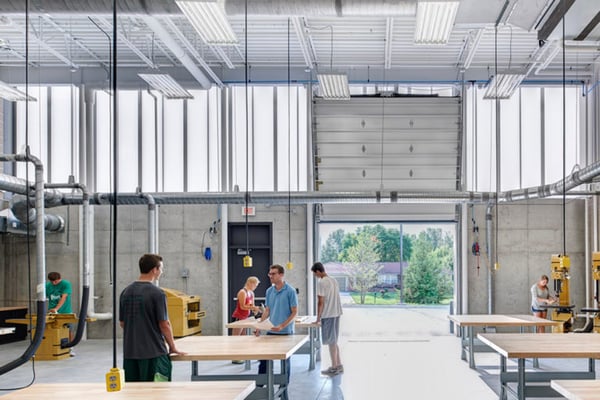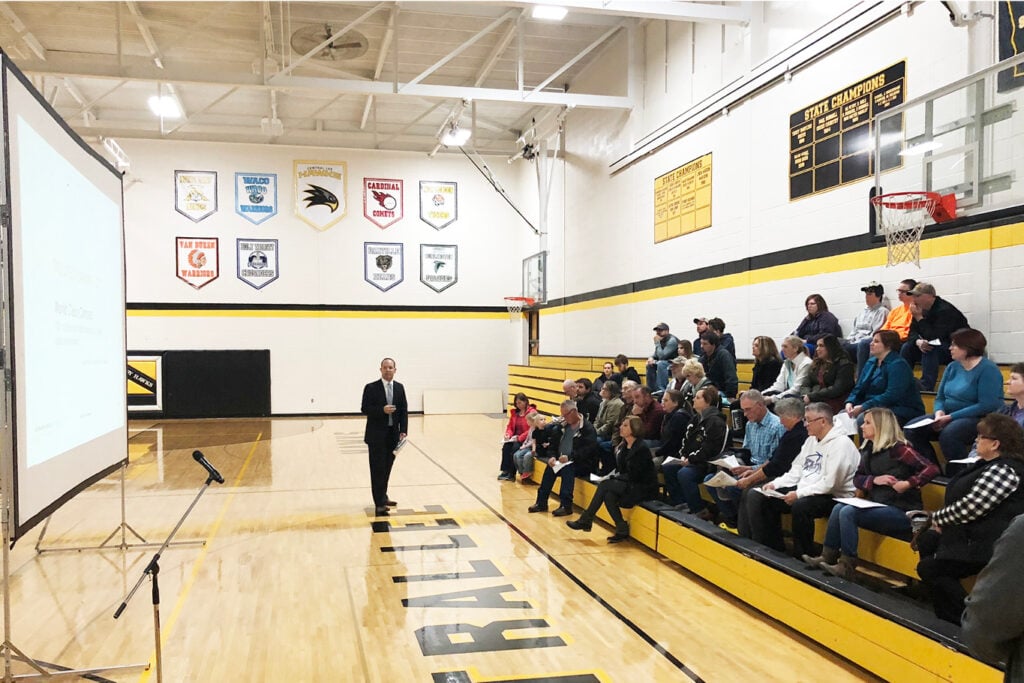Bond referendums are a common way to fund public building projects. For organizations like K-12 schools, bonds can help cover the cost of a new building or the cost of updating existing facilities. Passing a bond referendum, however, is far from easy.
Before a building project can receive funding, the community must vote on whether they are willing to extend a levy or increase their taxes to pay back a bond. This can be stressful and frustrating for school districts relying on bonds for funding. Luckily, architects can help you through the process.
At Neumann Monson, we have worked with several K-12 school districts that have successfully passed bond referendums. Our goal is to educate anyone entering this process and increase your chances of success.
To prepare you for the process ahead, this article will demystify bond referendums and explain how an architect can assist you.
What is a Bond Referendum?
A bond referendum is a public funding method where a community issues a general obligation bond and pays it back through taxpayer dollars. Although the funding method can be used for a variety of project types, public school districts often use it to update existing facilities or build a new school.
The Bond Referendum Process
According to the Iowa Department of Education, passing a bond referendum is a twelve-step process. These steps include:
- Determine the need for the project
- Assess needs
- Prepare educational specifications
- Determine the bond amount to be issued
- Create and circulate a bond petition
- Call the election
- Campaign for passage
- Approve preliminary plans
- Sell bonds
- Approve final Plans, specifications, and bidding requirements
- Complete the project
- Hold post-completion activities
These steps are specific to Iowa, but the process likely looks similar in any state. Generally, the School Board determines a need for a building project and partners with an architect or another consultant to determine the spacing and programming elements and how much the project will cost.
After a dollar amount for the project is established, the community is called to vote. If enough community members vote “yes,” the bond can fund the project. Over time, the bond will be paid back through tax revenue.

Cascade High addition, a project funded through a bond
How Architects Help with Bond Referendums
If your district is needing to pass a bond referendum, it is important to involve an architect as early as possible. An architect can assist with the early phases of the bond referendum process, helping you determine your needs, prepare educational specifications, and determine the bond amount to be issued.
Specifically, they can assist by:
- Engaging stakeholders
- Determining what to include
- Presenting the program to the public
- Creating renderings and videos
The architect’s aim should be to include as many community members as possible in the design process and factor their input into the final decision. They should also help you get the most out of your funding by finding solutions that maximize the budget’s efficiency.
1. Engaging Stakeholders
At the beginning of the bond referendum process, architects will engage stakeholders, including School Board members, parents, students, and teaching and administration staff. The goal is to get input from as many parties as possible and factor this input into the program and design.
Additionally, the architect may solicit input from community members. For example, some local businesses may have a vested interest in the community’s educational offerings and may want to use the opportunity to engage students. In the design of the Career Academy of Pella, local businesses suggested spaces that could house welding and robotics courses, which we factored into the design.
The community votes on whether to pass the bond, so it is important to hear their thoughts and concerns.

Career Academy of Pella
2. Determining What to Include
An architect can also determine the cost of the building project. They will start with making a list of priority items and researching costs.
The architect’s aim should be to help you “get the most bang for your buck.” In some cases, the architect may include lower priority items within your project, especially if it’s more cost-effective to address these items in conjunction with a higher priority item.
For example, your restroom facilities may be a low priority, but you will need to update them within the next ten years. In the future, it may be more expensive to renovate the restrooms, especially if this work could be incorporated into a higher priority item, like a cafeteria addition.
To make the bond as effective as possible, your architect may suggest updating the restrooms while you are completing the cafeteria addition.
This process may also include a facilities assessment. Working with a consultant, the architect can examine the mechanical, electrical, and plumbing systems and determine what needs to be updated. They will also examine the space for code compliance, safety, over-crowding, adaptation for new use, acoustics, daylighting, sustainability, and ADA (Americans with Disabilities Act) compliance.
Keep in mind: architects can only suggest what to include in the bond. Ultimately, it is up to the School Board to decide what project components to include.
3. Presenting the Program to the Public
After the School Board determines what to include in the bond, the architect can present the program to the public. A “program” is an architectural document that outlines the spaces needed and their requirements. For example, a program may list a new gymnasium, new locker rooms, a new HVAC system, and more.
Before the community votes, an architect can discuss the program with community members and explain the rationale behind the included components. Through this process, community members are more likely to understand the importance of the bond, increasing your chances of the bond referendum passing. As always, the architect will listen to feedback, and in some cases, adjust the program.
4. Creating Renderings and Videos
Passing a bond referendum is a political process. Although architects will not directly campaign for the school district, they can assist by supplying promotional materials. If requested, the architect can create renderings and even videos of the proposed spaces.
These images can then be used to help the community envision the proposed space and understand why they are voting.
Funding a Project Through a Bond Referendum
An architect can assist in the early phases of the bond referendum process, helping you determine your needs and engage the community. Although they cannot call the election or issue bonds, they will rejoin the process once the referendum passes.
The process of passing a bond referendum is not easy, but a quality architect will work with the community and find solutions that balance the community’s and district’s needs with the budget’s potential.
If your bond goes through, it is important that you get the most out of your funding and understand every cost associated with a building project. Learn what costs you are likely to encounter by reading our breakdown of construction and project costs.
